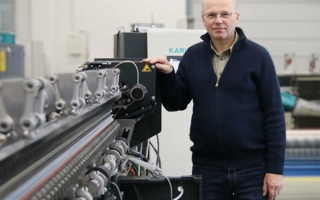06/12/2024 – Production Planning System — auf Deutsch lesen
Simplify production and maximize output
The web-based Production Planning System (PPS) from Stoll and KM.ON was created specifically for the flat knitting industry. It focuses on planning, controlling and optimizing production.
Today’s markets are fast-moving and volatile. They demand ever shorter response times and improved on-time delivery, and therefore modern IT solutions such as the Production Planning System (PPS) powered by Stoll and KM.ON.
With its advanced production planning and reporting features, the tool provides real-time insights into production and the ability to automate processes and reduce manual efforts. The PPS thus opens new paths to lower costs, greater overall efficiency and sustainability as well as improved processes. The basis for this is end-to-end data and process management. The PPS can be seamlessly integrated into all of the customer's systems, connecting them from machine control systems to ERP.
The digital solution for production management can be used anywhere and at any time via any mobile device, without any additional app or software. Production data can be shared effortlessly. This facilitates collaboration and enables remote working.
Features for the production planning
The most important benefits of the PPS include more automation and less manual intervention by personnel in flat knitting production. Setup times can be minimized, capacity utilization in the machine park maximized, and sustainable production enhanced. Other advantages include more planning accuracy than before and an improved responsiveness allowing for quick adjustments to the production schedules.
This performance is based on sophisticated production planning features, including one for status view and one for yarn calculation, as well as electronic ticketing and order management. The order status view feature provides real-time insights into the production capacity and order assignment. This quickly highlights plan deviations and enables automated planning simulations to optimize capacity utilization and ensure on-time production.
The calculation of yarn requirements and the resulting yarn consumption reports significantly enhance inventory management by providing transparency, preventing both under- and over-ordering.
With the digitalization of order management, all essential and supporting information is displayed directly on the machine via the ticket view. At the same time, the machine is configured correctly for production. This minimizes paperwork and reduces operational and communication errors. It also supports real-time order updating and tracking, thereby streamlining the production process.
Reports for data-based decisions
The PPS delivers comprehensive reports on production performance, enabling in-depth analysis, monitoring of key metrics, and identification of improvement areas. The resulting transparency helps customers fulfill their accountability obligations more effectively and enhances team collaboration. Key features include customizable reporting, data analysis, event and stop cause analyses, as well as forecasting and trend insights.
These reports provide detailed overviews, such as event lists, production reports, pattern statistics, stop statistics and yarn demand. Each report can be customized to focus on specific aspects of production.
Data analysis provides valuable insights for efficient monitoring of production performance and enables rapid responses to deviations and disruptions in the production process. Key performance indicators and metrics can also be tracked to identify trends and areas with potential for improvement.
Root cause analyses of stoppages and production delays form the basis for implementing corrective actions, improving operational reliability, and reducing waste.
The forecasting feature leverages historical data to predict future production requirements and optimize resource allocation. It also offers insights into production trends, supporting proactive management and necessary strategic adjustments.





